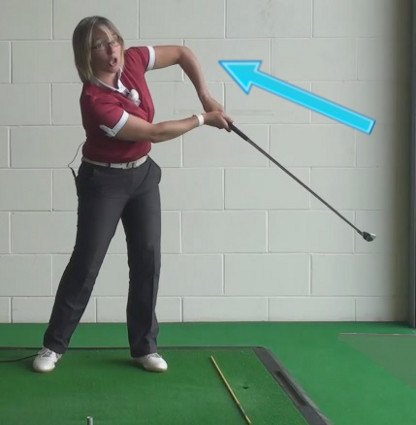In this golf tip we are going to first of all discuss what a chicken wing golf slice is and then once we have got a good understanding of it, we will then discuss how to correct it.

A chicken wing golf slice is where we see a slice that is a golf ball flying left to right in the air, being produced because of your left arm position and movement as you are hitting the ball and into your follow through. A chicken wing action sees your left arm and more specifically your left elbow bending upwards towards the sky as you are hitting the golf ball, producing an awkward and uncomfortable look in your left arm as your elbow points skywards after you have hit the ball.
Let us look at the effect that this action has on the movement of the club head as you are striking the golf ball and therefore the reason why we see a slice. Place an alignment pole on the ground to represent the line that we want to hit the ball down to our target. To hit a straight shot down this line, the club head needs to move directly along this line when you are striking the golf ball, with the club face also aiming along the line. If you make a chicken wing action, where your left elbow points upwards towards the sky as you hit the golf ball, the club head will get pulled to the inside of the target line as you make this action and movement. With the club face still aiming down the target line, or to the right of the direction that the head is travelling in, tilted axis spin will be put on the golf ball. This tilted axis spin, will now cause the ball to fly left to right in the air, producing a slice.
In order to correct your slice and to start hitting straighter golf shots, we need to improve your left arm movement so that the club head can move straighter along the target line during the strike of the golf ball and just after this. The correct movement for your left arm as you swing through your golf shot is that it should be straight at impact with the golf ball and then it should bend following this. However, whereas a chicken wing sees the left elbow bending upwards towards the sky following impact with the ball, the correct movement sees the left elbow bending so that the elbow points downwards towards the ground following impact. The left elbow should fold downwards and your lower left forearm and hand should rotate counter clockwise. Instead of seeing a large gap appearing between your left elbow/forearm and your right elbow/forearm, your arms should remain close together as they rotate, right forearm over left forearm.
To help you achieve this action, it is important to look at how your golf club is approaching the ball. If you are swinging down towards the ball with the club head on the outside of your target line, that is the far side of your target line. As a consequence, you will have to make a chicken wing action as you pull the club head towards the ball and then consequently on to the inside, or your side of the target line – your left arm has to respond in this way.
To correct the action, place an alignment pole or golf club on the floor to represent your target line. Take two head covers. Stand as though you are going to take your golf stance up and place one of the covers three inches to the right of the ball but on the far side (the outside) of the target line. Place the other head cover three inches to the left of the ball but on your side (the inside) of the target line. Now remove the alignment pole and take some gentle swings with your golf club. Swing down towards the ball so that you miss the right hand head cover on the inside of it and then swing past the left hand head cover on the far side of it. As you do this, work on keeping your forearms close together and allow your right forearm to roll over your left.
Practice this until you can swing the club without hitting either of the head covers and then once you feel more confident and successful with this, place a ball between them and make the same movement so that you do not hit either head cover.
Keep your forearms close together during your follow through and allow your right forearm to rotate over your left.






